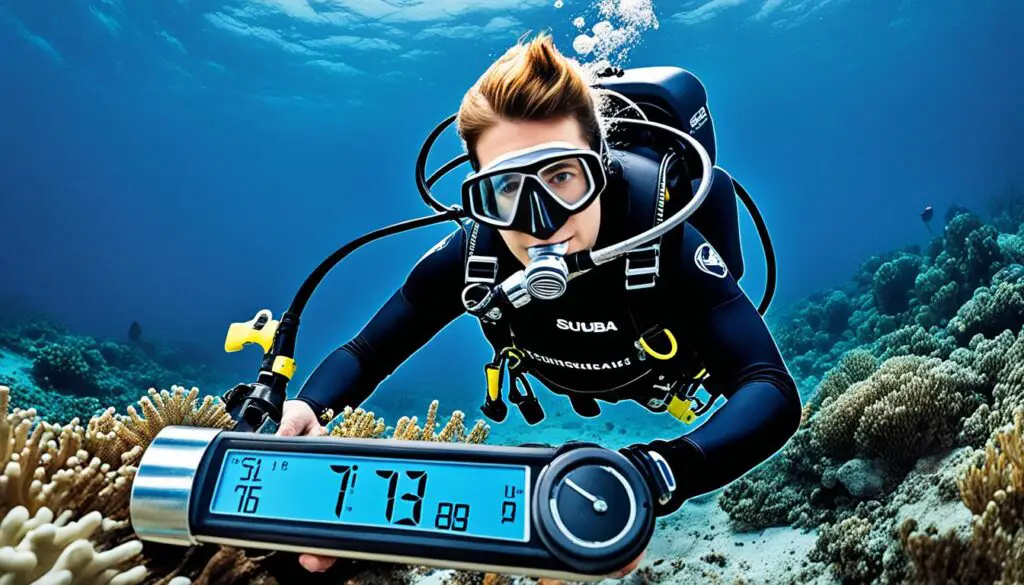Scuba diving is truly amazing, letting me see the beauty of the sea underneath. As someone who loves diving, making each dive better is always a goal. This is where scuba metrics are really useful.
In a study in the Movement Ecology journal, scientists looked at moving patterns in sea animals. They focused on southern elephant seals to see if they could tell how much they feed. The outcome was very interesting.
The study found something cool. Although not all moving patterns could tell how much the seals eat, their up and down speeds matter a lot. In fact, how fast they swim upwards while diving was the best hint. This shows that what happens during dives can help a lot to understand and improve how these predators eat.
Key Takeaways:
- Scuba metrics are key to making dives better.
- The speed at which sea animals go up during dives is great for predicting how much they eat.
- Looking at metrics from dives works better than just following their path.
- For making predictions, using trees is better than simple models.
- By knowing and using scuba metrics, we can boost how well sea animals eat.
Understanding Scuba Metrics
Scuba metrics help us study how marine animals find food in the sea. They tell us about their movements and dives. This information is key to knowing more about these creatures.
Theory says animals try to find food in the best way possible. They use special ways to move. These patterns let them find food without using too much energy. By looking at how fast they move and turn, we understand how hard they search for food.
Other metrics look at how they dive. These measurements show how well they find food under the water. By seeing if their dives get better, we learn about their hunting habits. This helps us protect them better.
“Understanding scuba metrics is crucial for unlocking the mysteries of marine predator behavior and informing conservation strategies.”
But, we must remember that these metrics work differently for each animal. Things like where they live, what food is available, and their body’s abilities matter a lot. So, we need to be careful and study them well to get the right answers.
The Importance of Scuba Metrics in Conservation
Scuba metrics are essential for saving marine animals. They show us where these animals go and what they need to survive. This helps us make plans to keep them safe.
These measurements also tell us about important places such as where they find food and rest. Knowing these spots, we can work to make sure they are protected. This helps them avoid dangers like losing their homes or being bothered.
By using scuba metrics, we can help keep our seas healthy. This way, we ensure that beautiful sea creatures continue to live well.
Visualizing Scuba Metrics
Seeing data on scuba metrics clearly can make a big difference. The table shows some important metrics and what they tell us. This helps us understand the habits and needs of marine animals. It’s crucial for protecting them.
| Scuba Metric | Application | Interpretation |
|---|---|---|
| Movement Patterns | Identifying foraging strategies | Evaluating resource encounter rate and movement efficiency |
| Transit Rate | Inferring foraging search intensity | Indicating areas of high prey density |
| Turning Angle | Assessing foraging effort | Quantifying resource exploration behavior |
| Dive Efficiency | Evaluating feeding activity | Measuring energy expenditure during dives |
Using this data, we get a full picture of marine life. This knowledge is key for solving challenges in conservation. It helps us protect these amazing animals for the future.

Using Scuba Metrics for Dive Planning
Scuba metrics, like RMV and SAC, help divers plan their dives better. RMV shows how much air a diver uses. This helps them know their normal breathing amount. SAC, on the other hand, tells how fast a diver uses up the air in their tank.
Knowing RMV and SAC helps divers figure out how much air they need for a dive. It lets them pick the right tank size. Many things affect how much air a diver uses, like their size, how hard they work, and the water’s temperature.
By learning to control their movements, divers can lower the air they need. This makes dives smoother and more fun. Using these dive metrics makes diving safer and more enjoyable. Divers feel more confident knowing they have enough air for a great dive.
FAQ
What are scuba metrics?
Scuba metrics are measurements that show how divers and ocean animals move and act. They reveal a lot about what’s going on underwater.
How do scuba metrics enhance the diving experience?
These measurements help divers dive better. They learn about their breath, how much air they use, and how they move. This knowledge helps them have more fun and efficient dives.
What can scuba metrics tell us about marine predators?
Scuba metrics give us info on how ocean predators hunt and eat. This helps us protect them and understand their role in the ocean.
What metrics are used to optimize dive planning and gas management?
RMV and SAC are two key metrics for planning how much air divers need. They help pick the right air tank. This planning makes diving safer and more enjoyable.
What factors can influence scuba metrics?
Many things can change these metrics, like your size, how hard you work, and the water’s temperature. Learning good diving skills and staying relaxed can lower these metrics. This way, you have a better dive.
